Disassemble your harmonica and wash all the parts with soap and warm water. If you can see any piled-up residue, remove it with a soft toothbrush. Let the parts air dry before reassembling your instrument.
Unfortunately, harmonicas aren’t exchangeable, serviceable, or refundable by retail stores because of health regulations.
In simpler words, once this instrument has been purchased or played by anyone, it’s seen as a used product and should be returned to the manufacturer by the customer for warranty service.
In today’s article, we’ll teach you how to clean and maintain your instruments to extend their life and keep your costs down, so let’s dive right in.
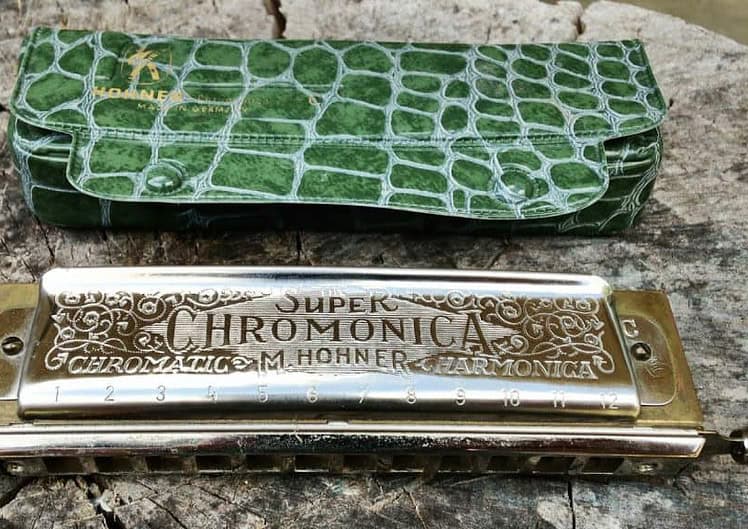
Why Clean A Harmonica?
The reason for cleaning a harmonica is obvious. It’s a mouth-blown instrument, so it’s susceptible to being a carrier of germs.
Also, playing this instrument contributes to the deterioration of the tone quality, reed pitch, and overall life.
The human breath carries many contaminants that pile up residue on the reeds, inside the cover plates and comb. Each person’s body chemistry is different, so different levels of sugar and other chemicals can be found in the saliva.
The contaminants we just mentioned, along with others that can be present from eating or drinking, will collect within the instrument and solidify on the components.
Any type of residue on the reeds will cause changes in the pitch, whereas piled-up dirt on the reed plates and inside surfaces of the cover plates can mess up the tone brilliance.
Regular and careful cleaning of your instrument will prevent bacteria growth and corrosion, extending the life of your harmonica.
How to Clean A Harmonica: Daily Guide
For starters, you should handle your harmonica carefully as it’s a fragile instrument. If you use one daily, here’s a guide on how to clean it properly.
Step 1: Rinse with Warm Water
If you own a diatonic instrument with a plastic comb, you can easily clean it with just water.
First, run warm water through your instrument, place the mouthpiece against your palm and tap it firmly to remove the water.
Note that you should only use water for the cleaning if the comb is plastic or sealed wood. If it’s a metal or wooden comb, don’t run lukewarm water through it, as it can cause damage to these materials over time.
Step 2: Tap the Instrument After Each Use
Since this instrument collects saliva and other contaminants, it’s suggested to clean it after each use.
You can tap the instrument on your leg, hand, or clean towel to shake off loose saliva. This will keep it clean and help decrease the amount of piled-up residue inside.
Moreover, try to be a dry player. In other words, try to decrease the amount of saliva you blow into the instrument while playing.
Step 3: Let Your Instrument Dry After Playing
You can also keep your instrument clean and corrosion-free by letting it completely dry after each use.
For instance, when you store your harmonica in the case, leave it open so it can dry. That way, any moisture in the instrument will dry instead of sitting there wet in your harmonica.
Extra Tip: Clean Your Mouth Before Playing
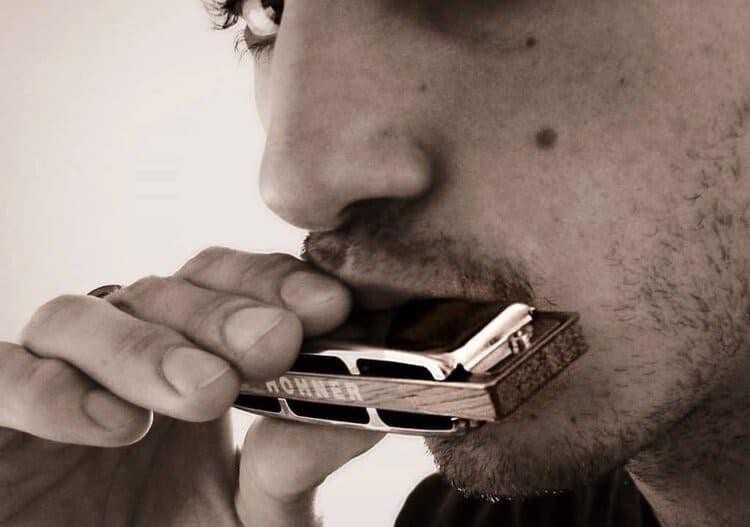
We highly suggest rinsing your mouth with water or brushing your teeth before playing, especially if you have consumed anything at the time.
Otherwise, sugar and other contaminants from various juices, alcohol, or other non-water beverages can build up a residue in the instrument.
If you brush your teeth before playing, don’t play immediately, as any residue left over from the mouthwash or toothpaste can build up.
Lastly, don’t smoke while playing the instrument as this can also cause damage.
How to Clean A Harmonica: Heavy Cleaning Guide
The heavy cleaning guide doesn’t involve just washing. It’s a more complex process that requires disassembling your harmonica.
Step 1: Take Off the Cover Plates
Using a screwdriver, take off the cover plates. Some harmonicas require a Phillips-head screwdriver, whereas others call for a flat head.
So, make sure you use a screwdriver of the appropriate shape and size and put the screws in a safe place where they won’t be lost.
Finally, spray both sides of the cover plates with rubbing alcohol and wipe with a clean cloth.
Step 2: Take Off the Reed Plates
Once you’re finished with the cover plates, take off the screws fastened to the reed plates. Store them in the same order you removed them so you don’t experience any difficulties putting them back in their holes.
Step 3: Soak the Reed Plates
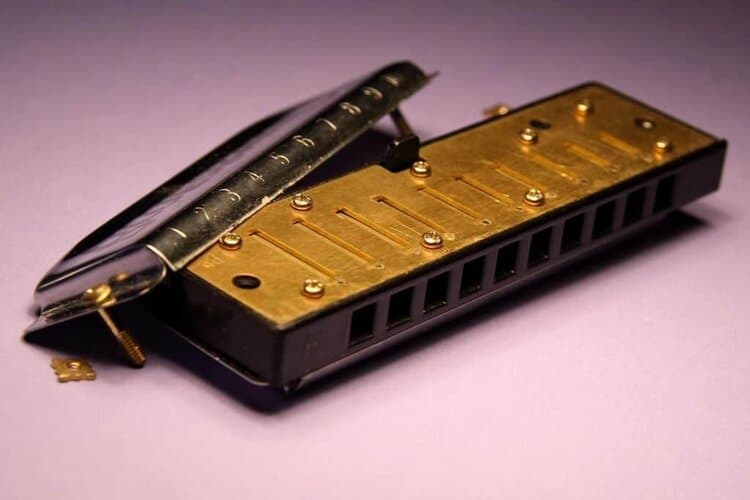
Make a cleaning solution of lukewarm water and lemon juice or vinegar. Then, place the reed plates inside the solution and let them soak for about 30 minutes.
Step 4: Take Care of the Comb
If it’s a plastic comb, you can clean it with a small amount of soap and water. Using a soft toothbrush, remove any build-up residue.
Alternatively, you can spray the comb with rubbing alcohol and brush it. If that doesn’t do the trick, use a sharp tool to remove any residue.
If it’s a wooden comb, avoid water and soap. A soft toothbrush or sharp tools can get the job done.
You can clean it with water and soap or rubbing alcohol if it’s a metal comb.
Lastly, make sure it’s completely dry before putting it back inside your harmonica. Otherwise, the metal can corrode over time because of moisture and damage other components of your instrument.
Step 5: Rinse the Reed Plates
Once you’re done with the comb, it’s time to remove the reed plates from the water.
Using a soft toothbrush, remove any build-up residue but don’t scrub them too much as this can cause damage or mess up the instrument’s notes.
Also, don’t brush across the reed. It’s suggested to brush in the direction of the reed. Finally, clean the other side of the plates as hard as you want since they don’t have any reeds.
When you’re done, rinse the plates under warm water.
Extra tip: If they’re still dirty, use a small amount of hydrogen peroxide and a q-tip to remove any piled-up residue.
Step 6: Reassemble Your Instrument
After cleaning, let all the parts dry before reassembling the instrument. Screw the screws back properly and tighten them as far as they can go.
How to Sterilize A Harmonica?
Some professionals sterilize their harmonica with ultrasonic cleaners and disinfectants (rinsing the reed plates under plain water after the ultrasonic bath).
We don’t suggest using ultrasonic cleaners. Instead, you can sterilize your harmonica in hydrogen peroxide as it’s easier. Do it once every 4-12 months when you notice a bitter flavor in the instrument.
If you opt for a hydrogen peroxide bath for sterilization, we advise you don’t do it too often. Note that frequent exposure to this substance will speed up the oxidation process.
Now, let’s learn how to sterilize a harmonica with hydrogen peroxide.
Step 1: Soak Your Harmonica in Hydrogen Peroxide
Pour 3% hydrogen peroxide into a bowl and soak your harmonica for 10 minutes.
Important note: If your immune system is compromised, take additional measures as this type of sterilization won’t be enough. Some bacteria aren’t destroyed by 3% hydrogen peroxide, so keep that in mind.
Step 2: Rinse Under Plain Water
Next, rinse your harmonica under tap water, then remove the moisture by shaking the instrument into a towel that’s held in the palm of your hand.
Step 3: Let It Dry
You can place your instrument in front of a fan or somewhere warm.
WARNING: Avoid using this sterilization technique if your instrument has a wood or bamboo comb. There’s a good chance that your harmonica will be fine if it’s soaked briefly and dried right away, but check with your manufacturer first just in case.
How to Maintain A Harmonica: Quick & Easy Guide
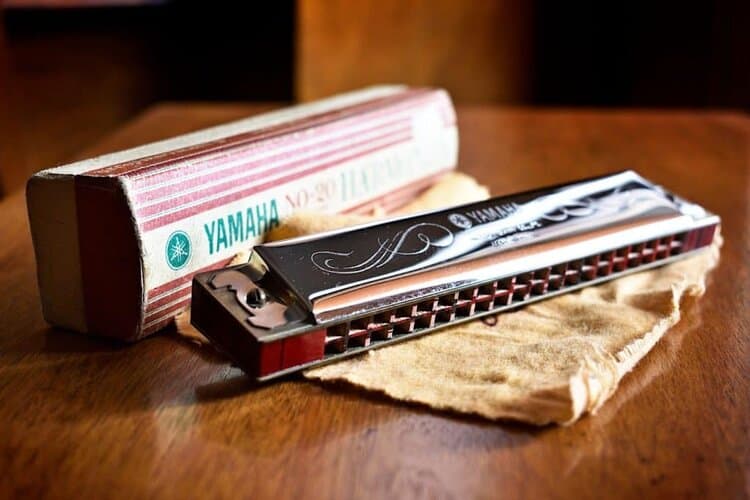
Why have your harmonica for only 6 months when you can have it for decades with proper maintenance?
Think of it as a vehicle. It’s loaded with moving mechanical parts; the more mileage you make, the faster the instrument will deteriorate.
And just like a vehicle, the moving mechanical compartments of harmonicas (reeds) will deteriorate much faster if they’re being played often and not with a clean mouth. They can also deteriorate if you’re playing your harmonica too loud.
With that being said, regular maintenance is the key to a long-lasting and germ-free instrument. Here’s how to maintain a harmonica in quick and easy steps.
Step 1: Don’t Play the Instrument Drunk
We know that you might feel the need to play the instrument while under the influence of alcohol, but we strongly advise against it.
If you play it drunk, there’s a high possibility that you will use strong air pressure, applying too much stress on the reeds, which will destroy your harmonica faster.
Thus, learn how to play with moderate air pressure at all times.
Step 2: Avoid Sharing Your Harmonica
Sharing your harmonica with others will not only pass on their germs to the parts of the instrument but also possibly cause damage to them as not everyone knows how to play it properly.
Step 3: Store It Properly
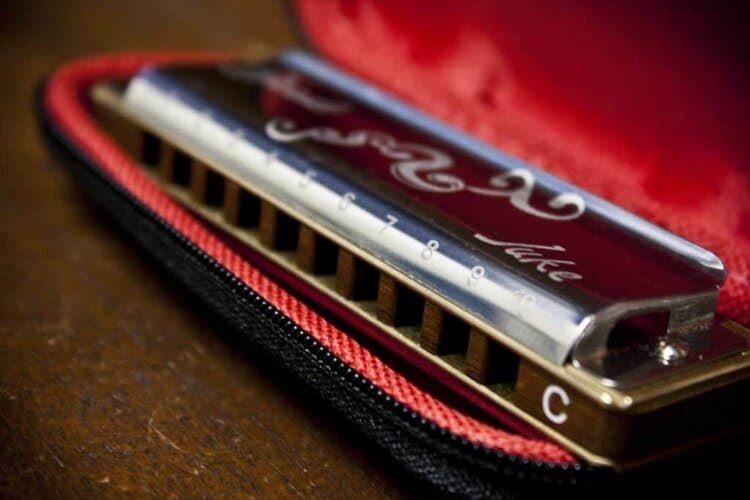
Keep your instrument in a case away from dust, coins, etc. Some people keep their harmonicas in their pockets, but that’s not a good idea.
If you don’t have a case, you can use a ziplock bag.
FAQs on How to Clean Harmonica
How do I get stains off my reed plates?
Make a cleaning solution of hot water and Keurig K-Cup machine cleaner and soak the reed plates for about 30 minutes before rinsing under lukewarm water.
What if my harmonica has no screws?
If your harmonica has no screws, it’s probably held together by small nails. You can carefully remove them with small tools (stylus knife or screwdriver), then replace them with similarly sized small screws.